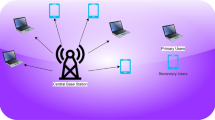Abstract
Recently, there has been a great deal of research on network mobility management that can support the movement of a mobile network consisting of several mobile nodes. The IETF NEMO working group proposed a basic support protocol, which defines methodology for supporting network mobility by using bi-directional tunneling between the home agent and the mobile router. This protocol, however, suffers from the ‘pinball routing problem,’ and most of the research attempts to solve this problem still have limitations in the efficiency of intra-domain communication. Moreover, these methods require additional binding procedures in case of the root mobile router handover. In this paper, we propose new route optimization methodology that can remedy these limitations by using asymmetric tunneling and a hierarchical local binding mechanism, which can provide faster signaling and data transmission. It can also be easily extended to support micro-mobility without the need for additional extensions. The performance is evaluated by simulation which can show the efficiency of the approach, compared with several previous route optimization methods.
Similar content being viewed by others
References
Cho, H. S., Paik, E. K., & Choi, Y. H. (2003). R-BU: Recursive binding update for route optimization in nested mobile networks.In Proceedings of the IEEE vehicular technology conference 2003, Orlando, USA.
Devarapalli, V., Wakikawa, R., Petrescu, A., & Thubert, P. (2005). Network mobility (NEMO) basic support protocol. RFC 3963.
Ernst, T., Mitsuya, K., & Uehara, K. (2003). Network mobility from the internetcar perspective. In Proceedings of the 17th international conference on advanced information networking and applications, 19–26.
Ernst, T. (2005). Network mobility support goals and requirements. IETF, Internet draft < draft-ietf-nemo-requirements-05 > .
Ernst, T., Lach, H. Y. (2005). Network mobility support terminology. IETF, Internet draft < draft-ietf-nemo-terminology-04 > .
Gu, Z. J., Yang, D. M., & Kim, C. H. (2004). Mobile IPv6 extensions to support nested mobile networks. In Proceedings of the 18th international conference on advanced information networking and applications, Fukuoka, Japan.
Jeong, M. S., & Park, J. T. (2004).Hierarchical mobile network routing: route optimization and micro-mobility support for a NEMO. In Proceedings of the international conference on embedded and ubiquitous computing 2004, lecture Notes in Computer Science 3207/2004, pp. 571–580.
Johnson, D., Perkins, C., & Arkko, J. (2004). Mobility support in IPv6. RFC 3775.
Kang, H. S., Kim, K. C., Han, S. Y., Lee, K. J., & Park, J. S. (2003). Route optimization for mobile network by using Bi-directional between home agent and top level mobile router. IETF, Internet draft < draft-hkang-nemo-ro-tlmr-00 > . Available: http://ietfreport.isoc.org/idref/draft-hkang-nemo-ro-tlmr/.
Lach H.Y., Janneteau C., Petrescu A. (2003). Network mobility in Beyond-3G systems. IEEE Communication Magazine 41: 54–57
Ng, C., Paik, E., Ernst, T., & Bagnulo, M. (2005). Analysis of multihoming in network mobility support. IETF, Internet draft < draft-ietf-nemo-multihoming-issues-04 > .
Na, J. K., Choi, J. H., Cho, S. H., Kim, C. K., Lee, S. J., Kang, H. J., & Koo, C. H. (2004). A unified route optimization scheme for network mobility. In Proceedings of the International ConferencePersonal on Wireless Communications 2004, Lecture Notes in Computer Science, Vol. 3260, pp. 29–38.
Na, J. K., Cho, S. H., Kim, C. K., & Koo, C. H. (2004). Generic route optimization model for nemo extended support. IETF, Internet draft < draft-na-nemo-gen-ro-model-00 > . Available: http://ietfreport.isoc.org/idref/draft-na-nemo-gen-ro-model/.
Ohnishi, H., Sakitani, K., & Takagi, Y. (2003). HMIP based route optimization method in a mobile network. IETF, Internet draft < draft-ohnishi-nemo-ro-hmip-00 > . Available: http://ietfreport.isoc.org/idref/draft-ohnishi-nemo-ro-hmip/.
Park, M. H., Park, C. M., Kim, S. H., Hong, S. B., & Choi, J. S. (2004). A novel routing protocol for personal area network mobility (PANEMO) environment. In Proceedings of the International Conference Advanced Communication Technology, Phoenix Park, Korea.
Perera E., Sivaraman V., Seneviratne A. (2004). Survey on network mobility support. Mobile Computing and Communications Review 8(2): 7–19
Thubert, P., Wakikawa, R., & Devarapalli, V. (2005). NEMO home network models. IETF, Internet draft < draft-ietf-nemo-home-network-models-05 > .
Thubert, P., Molteni, M., Ng, C., Ohnishi, H., & Paik, E. (2005). Taxonomy of route optimization models in the Nemo context. IETF, Internet draft < draft-thubert-nemo-ro-taxonomy-03 > . Available: http://ietfreport.isoc.org/idref/draft-thubert-nemo-ro-taxonomy/.
Thubert, P., & Molteni, M. (2004). IPv6 reverse routing header and its application to mobile networks. IETF, Internet draft < draft-thubert-nemo-reverse-routing-header-05 > . Availabe: http://ietfreport.isoc.org/idref/draft-thubert-nemo-reverse-routing-header/.
Wells, J. D. (2003). A network mobility survey and comparison with a mobile ip multiple home address extension. M.S.Thesis, VirginiaPolytechnic Institute and State University,, Virginia, USA.
Author information
Authors and Affiliations
Corresponding author
Rights and permissions
About this article
Cite this article
Jeong, M.S., Cho, Y.H. & Park, J.T. Hierarchical mobile network binding scheme for route optimization in NEMO. Wireless Pers Commun 43, 975–995 (2007). https://doi.org/10.1007/s11277-007-9257-4
Received:
Accepted:
Published:
Issue Date:
DOI: https://doi.org/10.1007/s11277-007-9257-4




